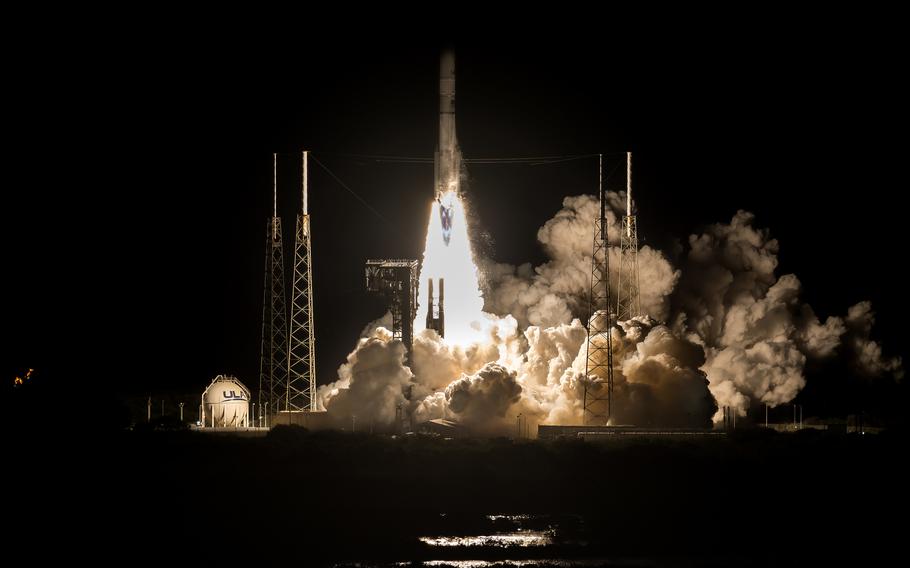
The ULA’s CPLS Peregrine Mission 1, supporting NASA’s Artemis program, lifts off from Launch Pad 41 at Cape Canaveral Space Force Station in Brevard County, Fla., on Jan. 8, 2024. (George Wilson, NurPhoto via Zuma Press/TNS)
(Tribune News Service) — While Astrobotic Technology’s moon landing hopes were dashed soon after liftoff this month from the Space Coast, the Peregrine lunar lander has continued to remain alive in its new role as a spacecraft despite continued warnings the vehicle would lose power.
Despite its tenacity, the Pittsburgh-based company that became the first to launch on one of NASA’s Commercial Lunar Payload Services ( CLPS) contracts, has opted to bring Peregrine back to Earth to burn up in its atmosphere.
The company announced the decision Sunday after conferring with NASA and other U.S. government agencies stating, “we must balance our own desire to extend Peregrine’s life, operate payloads, and learn more about the spacecraft, with the risk that our damaged spacecraft could cause a problem in cislunar space.”
Cislunar space is the space between the Earth and the moon.
“We have made the difficult decision to maintain the current spacecraft’s trajectory to reenter the Earth’s atmosphere. By responsibly ending Peregrine’s mission, we are doing our part to preserve the future of cislunar space for all,” the company wrote in a press release.
ULA’s new Vulcan Centaur blasts off for 1st time in Space Coast launch
The spacecraft took off on the debut launch of United Launch Alliance’s Vulcan Centaur on Jan. 8 from Cape Canaveral Space Force Station with what at first seemed to be a successful deployment. Despite establishing communications, mission managers soon found Peregrine was not able to maintain a sun-facing position so its solar arrays could generate power.
Troubleshooting revealed a propellant leak as the culprit, but teams had been able to compensate with other engines on board and keep it powered up, but initial warnings suggested it would lose power less than two days after liftoff, and taking any chance of a lunar landing off the board.
Peregrine, though, as of Tuesday morning has remained alive more than seven days having traveled more than 238,000 miles away. While that equals lunar distance from the Earth, the moon was nowhere near its position at the point as the original planned trajectory called for it to travel out that distance, but then back in to Earth for a gravity assist to then jet back out for a final lunar rendezvous and landing attempt in late February.
Human remains mission to the moon draws criticism from Navajo Nation
So while the propulsion leak remains, teams over the last week have been able to stabilize the vehicle and communicate with every payload on board that required powering up. The small lander has on board five payloads under the NASA CLPS contract and several others ranging from lunar rovers for the Mexican space agency and Carnegie Mellon University to human remains that were designed to become a permanent lunar memorial. The latter payload drew criticism from the Navajo Nation.
CLPS missions are part of NASA’s goal to become simply a customer to a growing lunar commercial market so it can focus on its human landing missions as part of its Artemis program. Companies are given fixed contracts to develop their own landers, procure a ride to space and handle all the communication. For Peregrine, Astrobotic received $108 million. NASA stated the value of its five payloads were about $5 million, and backup versions of four of the five payloads will fly on future CLPS missions.
The company did successfully fire up one of its main engines for the first time over the weekend but it wouldn’t be enough for any chance of an actual landing, the company said.
“We achieved a 200 millisecond burn and acquired data that indicated Peregrine could have main engine propulsive capability. However, due to the anomaly, the fuel to oxidizer ratio is well outside of the normal operating range of the main engines making long controlled burns impossible,” the company said.
Instead, it expected Peregrine would have enough propellant to continue to maintain its sun-facing energy position and make small maneuvers. Data suggested it could have remained operational for several more weeks and had its orbit raised high enough to miss Earth, but opted for the end-of-mission reentry instead.
“We must take into consideration the anomalous state of the propulsion system and utilize the vehicle’s onboard capability to end the mission responsibly and safely,” the company said. “We do not believe Peregrine’s reentry poses safety risks, and the spacecraft will burn up in Earth’s atmosphere.”
As of Tuesday and on its way back to Earth about 218,000 miles away, the propellant leak had “practically stopped,” the company stated. Astrobotic remains in discussion with NASA on Its final trajectory and exact time it will burn up in Earth’s atmosphere some time on Thursday morning.
“I am so proud of what our team has accomplished with this mission. It is a great honor to witness firsthand the heroic efforts of our mission control team overcoming enormous challenges to recover and operate the spacecraft after [Jan. 8’s] propulsion anomaly,” said Astrobotic CEO, John Thornton.
NASA’s CLPS efforts to get a lander on the moon will have several more opportunities this year including a planned launch in February of Houston-based Intuitive Machines with its Nova-C lander launching atop a SpaceX Falcon 9 with a potential lunar touchdown on Feb. 22.
Astrobotic also has another mission planned with its larger Griffin lander slated to fly on a SpaceX Falcon heavy at the end of the year.
©2024 Orlando Sentinel.
Visit orlandosentinel.com.
Distributed by Tribune Content Agency, LLC.